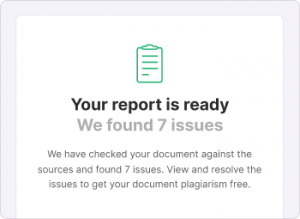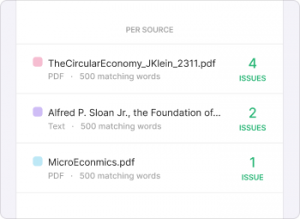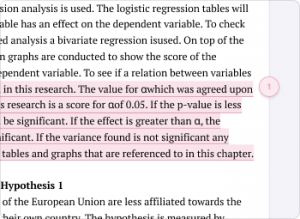What happens if you plagiarise?
The consequences of plagiarism vary depending on the type of plagiarism and the context in which it occurs. For example, submitting a whole paper by someone else will have the most severe consequences, while accidental citation errors are considered less serious.
If you’re a student, then you might fail the course, be suspended or expelled, or be obligated to attend a workshop on plagiarism. It depends on whether it’s your first offence or you’ve done it before.
As an academic or professional, plagiarising seriously damages your reputation. You might also lose your research funding or your job, and you could even face legal consequences for copyright infringement.
Frequently asked questions:
Plagiarism
-
Can I plagiarise myself?
-
Yes, reusing your own work without citation is considered self-plagiarism. This can range from resubmitting an entire assignment to reusing passages or data from something you’ve handed in previously.
Self-plagiarism often has the same consequences as other types of plagiarism. If you want to reuse content you wrote in the past, make sure to check your university’s policy or consult your professor.
-
Do I have to cite common knowledge?
-
Common knowledge does not need to be cited. However, you should be extra careful when deciding what counts as common knowledge.
Common knowledge encompasses information that the average educated reader would accept as true without needing the extra validation of a source or citation.
Common knowledge should be widely known, undisputed, and easily verified. When in doubt, always cite your sources.
-
What is plagiarism?
-
Plagiarism means presenting someone else’s work as your own without giving proper credit to the original author. In academic writing, plagiarism involves using words, ideas, or information from a source without including a citation.
Plagiarism can have serious consequences, even when it’s done accidentally. To avoid plagiarism, it’s important to keep track of your sources and cite them correctly.
-
What are examples of academic dishonesty?
-
Academic dishonesty can be intentional or unintentional, ranging from something as simple as claiming to have read something you didn’t to copying your neighbour’s answers on an exam.
You can commit academic dishonesty with the best of intentions, such as helping a friend cheat on a paper. Severe academic dishonesty can include buying a pre-written essay or the answers to a multiple-choice test, or falsifying a medical emergency to avoid taking a final exam.
-
What are the consequences of academic dishonesty?
-
Consequences of academic dishonesty depend on the severity of the offence and your institution’s policy. They can range from a warning for a first offence to a failing grade in a course to expulsion from your university.
For those in certain fields, such as nursing, engineering, or lab sciences, not learning fundamentals properly can directly impact the health and safety of others. For those working in academia or research, academic dishonesty impacts your professional reputation, leading others to doubt your future work.
-
What is academic dishonesty?
-
Academic dishonesty refers to deceitful or misleading behavior in an academic setting. Academic dishonesty can occur intentionally or unintentionally, and it varies in severity.
It can encompass paying for a pre-written essay, cheating on an exam, or committing plagiarism. It can also include helping others cheat, copying a friend’s homework answers, or even pretending to be sick to miss an exam.
Academic dishonesty doesn’t just occur in a classroom setting, but also in research and other academic-adjacent fields.
-
What is academic integrity?
-
Academic integrity means being honest, ethical, and thorough in your academic work. To maintain academic integrity, you should avoid misleading your readers about any part of your research and refrain from offences like plagiarism and contract cheating, which are examples of academic misconduct.
-
What is self-plagiarism?
-
Self-plagiarism means recycling work that you’ve previously published or submitted as an assignment. It’s considered academic dishonesty to present something as brand new when you’ve already gotten credit and perhaps feedback for it in the past.
If you want to refer to ideas or data from previous work, be sure to cite yourself.
-
Is plagiarism illegal?
-
Plagiarism has serious consequences and can be illegal in certain scenarios.
While most of the time plagiarism in an undergraduate setting is not illegal, plagiarism or self-plagiarism in a professional academic setting can lead to legal action, including copyright infringement and fraud. Many scholarly journals do not allow you to submit the same work to more than one journal, and if you do not credit a coauthor, you could be legally defrauding them.
Even if you aren’t breaking the law, plagiarism can seriously impact your academic career. While the exact consequences of plagiarism vary by institution and severity, common consequences include a lower grade, automatically failing a course, academic suspension or probation, and even expulsion.
-
When do I need to cite myself?
-
If you are reusing content or data you used in a previous assignment, make sure to cite yourself. You can cite yourself the same way you would cite any other source: simply follow the directions for the citation style you are using.
Keep in mind that reusing prior content can be considered self-plagiarism, so make sure you ask your instructor or consult your university’s handbook prior to doing so.
-
What is patchwork plagiarism?
-
Patchwork plagiarism, also called mosaic plagiarism, means copying phrases, passages, or ideas from various existing sources and combining them to create a new text. This includes slightly rephrasing some of the content, while keeping many of the same words and the same structure as the original.
While this type of plagiarism is more insidious than simply copying and pasting directly from a source, plagiarism checkers can still easily detect it.
To avoid plagiarism in any form, remember to reference your sources.
-
What is verbatim plagiarism?
-
Verbatim plagiarism means copying text from a source and pasting it directly into your own document without giving proper credit.
If the structure and the majority of the words are the same as in the original source, then you are committing verbatim plagiarism. This is the case even if you delete a few words or replace them with synonyms.
If you want to use an author’s exact words, you need to quote the original source by putting the copied text in quotation marks and including an in-text citation.
-
What is global plagiarism?
-
Global plagiarism means taking an entire work written by someone else and passing it off as your own. This can include getting someone else to write an essay or assignment for you, or submitting a text you found online as your own work.
Global plagiarism is one of the most serious types of plagiarism because it involves deliberately and directly lying about the authorship of a work. It can have severe consequences for students and professionals alike.
-
How is plagiarism detected?
-
Plagiarism can be detected by your professor or readers if the tone, formatting, or style of your text is different in different parts of your paper, or if they’re familiar with the plagiarised source.
Many universities also use plagiarism detection software, which compares your text to a large database of other sources, flagging any similarities that come up.
It can be easier than you think to commit plagiarism by accident. Consider using a plagiarism checker prior to submitting your essay to ensure you haven’t missed any citations.
-
Are plagiarism checkers accurate?
-
The accuracy depends on the plagiarism checker you use. Per our in-depth research, Scribbr is the most accurate plagiarism checker. Many free plagiarism checkers fail to detect all plagiarism or falsely flag text as plagiarism.
Plagiarism checkers work by using advanced database software to scan for matches between your text and existing texts. Their accuracy is determined by two factors: the algorithm (which recognises the plagiarism) and the size of the database (with which your document is compared).
-
Can plagiarism be accidental?
-
Accidental plagiarism is one of the most common examples of plagiarism. Perhaps you forgot to cite a source, or paraphrased something a bit too closely. Maybe you can’t remember where you got an idea from, and aren’t totally sure if it’s original or not.
These all count as plagiarism, even though you didn’t do it on purpose. When in doubt, make sure you’re citing your sources. Also consider running your work through a plagiarism checker tool prior to submission, which work by using advanced database software to scan for matches between your text and existing texts.
Scribbr’s Plagiarism Checker takes less than 10 minutes and can help you turn in your paper with confidence.




